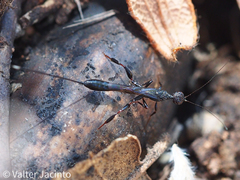Mantispa styriaca

Mantispa styriaca is a fascinating insect belonging to the order Neuroptera, which is known for its distinct mantis-like appearance. Commonly referred to as the 'European mantisfly', this species is part of the family Mantispidae.
In the Valencia region, this insect might also be known locally due to its presence in diverse habitats, ranging from woodlands to grasslands. Observing its unique characteristics is a delight for entomologists and nature enthusiasts alike.
- Appearance: Mantispa styriaca is easily identifiable by its elongated thorax and raptorial front legs, which it uses much like a praying mantis to capture prey. The wings are clear with distinct venation, contributing to its delicate appearance.
- Behavior: This species is predatory and primarily feeds on small insects. The distinct forelegs are adapted for grasping prey, making it an efficient hunter.
- Lifecycle: Like other lacewings, the lifecycle includes egg, larval, pupal, and adult stages. The larvae are known for their parasitic behavior, often developing inside spider egg sacs.
- Habitat: Mantispa styriaca is typically found in warm, temperate regions, favoring environments with abundant vegetation and insect populations.
- Importance: As a predator of other insects, Mantispa styriaca plays a crucial role in controlling pest populations, thus contributing to the ecological balance.
For those interested in observing Mantispa styriaca in its natural habitat, the Comunidad Valenciana provides an ideal setting with its diverse ecosystems and rich biodiversity.







